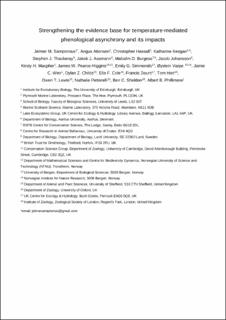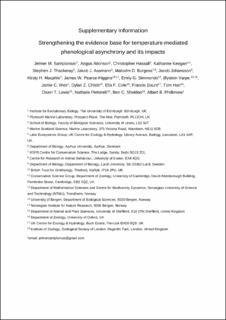Strengthening the evidence base for temperature-mediated phenological asynchrony and its impacts
| dc.contributor.author | Samplonius, Jelmer | |
| dc.contributor.author | Atkinson, Angus | |
| dc.contributor.author | Hassall, Christopher | |
| dc.contributor.author | Keogan, Katherine | |
| dc.contributor.author | Thackeray, Stephen J. | |
| dc.contributor.author | Assmann, Jakob J. | |
| dc.contributor.author | Burgess, Malcolm D. | |
| dc.contributor.author | Macphie, Kirsty H | |
| dc.contributor.author | Pearce-Higgins, James W. | |
| dc.contributor.author | Simmonds, Emily Grace | |
| dc.contributor.author | Johansson, Jacob | |
| dc.contributor.author | Varpe, Øystein | |
| dc.contributor.author | Weir, James C | |
| dc.contributor.author | Childs, Dylan Z. | |
| dc.contributor.author | Cole, Ella F. | |
| dc.contributor.author | Daunt, Francis | |
| dc.contributor.author | Hart, Tom | |
| dc.contributor.author | Lewis, Owen T. | |
| dc.contributor.author | Pettorelli, Nathalie | |
| dc.contributor.author | Sheldon, Ben C. | |
| dc.contributor.author | Phillimore, Albert B. | |
| dc.date.accessioned | 2021-03-16T15:59:52Z | |
| dc.date.available | 2021-03-16T15:59:52Z | |
| dc.date.created | 2021-01-12T10:49:08Z | |
| dc.date.issued | 2020 | |
| dc.identifier.issn | 2397-334X | |
| dc.identifier.uri | https://hdl.handle.net/11250/2733766 | |
| dc.description.abstract | Climate warming has caused the seasonal timing of many components of ecological food chains to advance. In the context of trophic interactions, the match–mismatch hypothesis postulates that differential shifts can lead to phenological asynchrony with negative impacts for consumers. However, at present there has been no consistent analysis of the links between temperature change, phenological asynchrony and individual-to-population-level impacts across taxa, trophic levels and biomes at a global scale. Here, we propose five criteria that all need to be met to demonstrate that temperature-mediated trophic asynchrony poses a growing risk to consumers. We conduct a literature review of 109 papers studying 129 taxa, and find that all five criteria are assessed for only two taxa, with the majority of taxa only having one or two criteria assessed. Crucially, nearly every study was conducted in Europe or North America, and most studies were on terrestrial secondary consumers. We thus lack a robust evidence base from which to draw general conclusions about the risk that climate-mediated trophic asynchrony may pose to populations worldwide. | en_US |
| dc.language.iso | eng | en_US |
| dc.publisher | Nature Research | en_US |
| dc.title | Strengthening the evidence base for temperature-mediated phenological asynchrony and its impacts | en_US |
| dc.type | Journal article | en_US |
| dc.type | Peer reviewed | en_US |
| dc.description.version | acceptedVersion | en_US |
| dc.source.pagenumber | 155–164 | en_US |
| dc.source.volume | 5 | en_US |
| dc.source.journal | Nature Ecology and Evolution | en_US |
| dc.identifier.doi | https://doi.org/10.1038/s41559-020-01357-0 | |
| dc.identifier.cristin | 1869674 | |
| dc.description.localcode | Publisher embargo applies until June 1, 2021 | |
| cristin.ispublished | true | |
| cristin.fulltext | postprint | |
| cristin.fulltext | postprint | |
| cristin.qualitycode | 1 |
Tilhørende fil(er)
Denne innførselen finnes i følgende samling(er)
-
Institutt for matematiske fag [2530]
-
Publikasjoner fra CRIStin - NTNU [38688]

